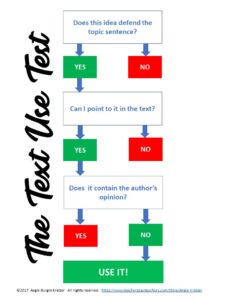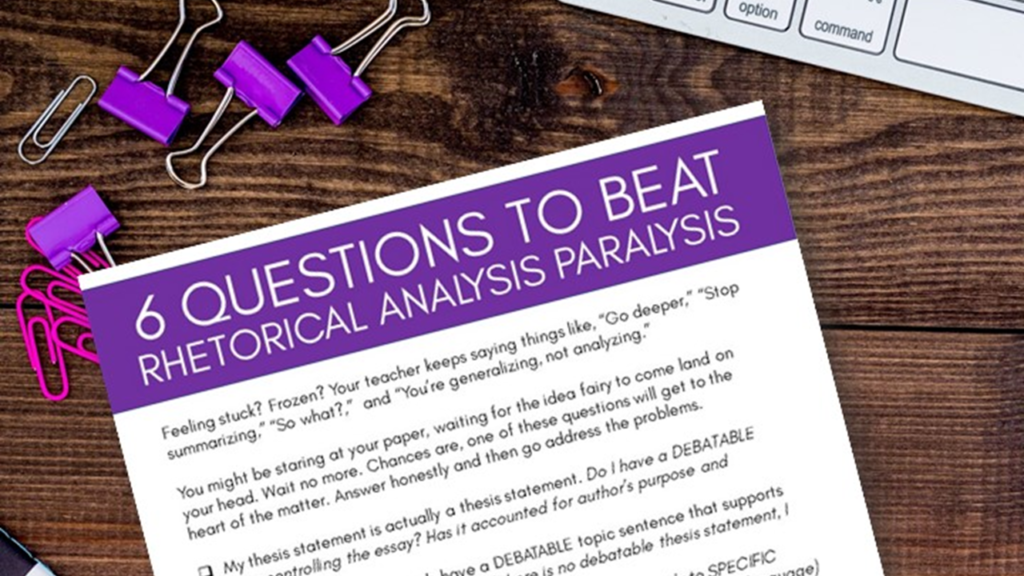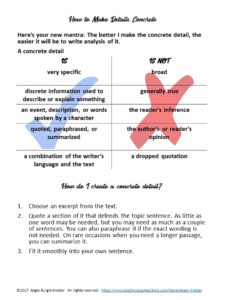
Call it a concrete detail, evidence, or proof. What defends a debatable idea is REAL, TRUE, FACTUAL, and APART from debate. If the topic sentence defends the thesis, and the concrete detail is strong, commentary will be (almost) a breeze. If the concrete detail is weak, irrelevant, general, or loosely paraphrased, the student WILL hit a brick wall on commentary. So, how do we help students to avoid milk toast concrete details?
1. Require that students put a finger on the evidence.
When I’m teaching my students how to craft a concrete detail, I require them to point to the evidence in the text itself. If the student is discussing figurative language, she has to put her finger on that extended metaphor she wants to discuss. If she can’t point to it, it’s not evidence.
When working on literary analysis, I give my students these two anchor charts for their binders.

When we move on to writing about broader movements, tone shifts, organization, and longer narrative methods of development, being able to point to evidence is a little harder. I can’t exactly point to organization, but I can describe in detail where the shifts happen. I can’t spend all my time paraphrasing a long story used as support, but I can write a precise summary that lends itself to solid commentary.
2. Highlight the difference between generalization, summary, and concrete detail.
Have students complete a sort to help them see the difference between what they ARE doing and what you WANT them to do. Give students 9-12 slips of paper, each of which contains a well-worded concrete detail, a vague generalization, or a summary of a text element that would be better represented by a quotation. Have students draw a three-column chart (You could even do this activity in groups with chart paper.). At the top of each column, students write CONCRETE DETAIL, GENERALIZATION, or SUMMARY. You then give class time for students to sort the slips of paper so that the difference pops out at them.
It might work better to create a sort on Google Slides. Just make a grid for the categories and turn the examples into images so students can manipulate them.
3. Steal from a gallery walk.
My students LOVE getting to steal from one another when we’re working on process essays. Here’s how it works: Once I have modeled how to construct a concrete detail, and we have written one together as a shared exercise, students then write them in pairs and put them on the white board or post them using chart paper. I then walk from one to the next and discuss the merits of each one. Where appropriate, we tweak as a group. By the time we’re done, there are 15 or so usable concrete details around the classroom. As students are about to move into independent practice, they are allowed to “steal” one of the concrete details if need be. When they eventually turn in a body paragraph to me, one of the concrete details might be “stolen,” but the analysis of it will be the student’s.
4. Model the process aloud.
We are teaching two categories of things in an English classroom–knowledge and skills. For knowledge, I can tell a student what evidence is, show him what it looks like, and extend that into asking him to show me supporting evidence as well. For the construction of evidence, however, not so much. If you’ve followed me for any length of time, you know that one of my mantras is You’re the best writer in the room. Students need to watch and listen while the teacher constructs a concrete detail. Ideally, the teacher is facing the class while physically writing under a document camera. Students need to hear the teacher make the selection, decide how much of it to quote (or whether to quote), and smoothly incorporate the text. They need to see the flubs, the erasures, the edits, the re-dos, and even the ball-it-up-and-start-overs. Hands down, the hardest part of modeling is the vulnerability of students watching you while you try to figure something out. One trick for a first model is to practice it so that it sounds like it’s off the cuff. Eventually, you want to get brave enough to look at a cold text and model the thinking. That may be the most powerful rhetorical analysis lesson you’ve ever taught.
If you need a bit moe support reinforcing commentary, you might show students this short video.
Looking to improve student commentary? Grab this commentary anchor chart.



